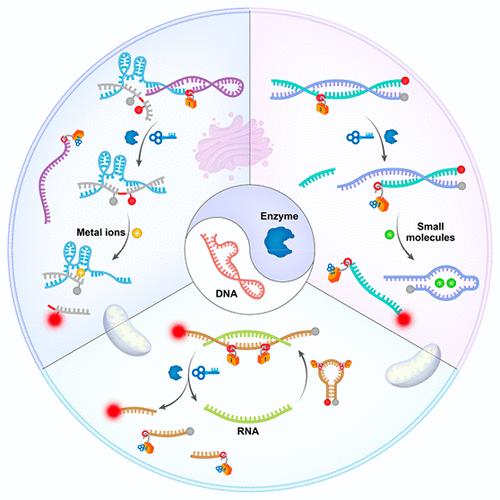当前位置:
X-MOL 学术
›
Acc. Chem. Res.
›
论文详情
Our official English website, www.x-mol.net, welcomes your
feedback! (Note: you will need to create a separate account there.)
Enzyme-Triggered DNA Sensor Technology for Spatially-Controlled, Cell-Selective Molecular Imaging
Accounts of Chemical Research ( IF 16.4 ) Pub Date : 2023-06-01 , DOI: 10.1021/acs.accounts.3c00085 Mengyuan Li 1 , Lele Li 2, 3
Accounts of Chemical Research ( IF 16.4 ) Pub Date : 2023-06-01 , DOI: 10.1021/acs.accounts.3c00085 Mengyuan Li 1 , Lele Li 2, 3
Affiliation

|
With unparalleled programmability, DNA has evolved as a powerful scaffold for engineering intricate and dynamic systems that can perform diverse tasks. By allowing serial detection of molecular targets in complex cellular milieus, increasingly sophisticated DNA sensors have not only promoted significant advances in unveiling the fundamental mechanisms of various pathophysiological processes but also provided a useful toolkit for disease diagnostics based on molecular signatures. Despite much progress, an inherent limitation of DNA-based sensors is that they often lack spatial control and cell-type selectivity for the sensing activity because of their “always active” design mechanism. Since most molecular targets of interests are not exclusive to disease cells, they are also shared by normal cells, the application of such biosensors for disease-specific imaging is limited by inadequate signal-to-background ratios due to indistinguishable signal response in both disease and normal cells. Therefore, imparting biosensors with spatial controllability remains a key issue to achieve molecular imaging with high sensitivity and cell specificity.
中文翻译:

用于空间控制、细胞选择性分子成像的酶触发 DNA 传感器技术
凭借无与伦比的可编程性,DNA 已发展成为一个强大的支架,用于设计能够执行各种任务的复杂动态系统。通过允许对复杂细胞环境中的分子靶标进行连续检测,日益复杂的 DNA 传感器不仅在揭示各种病理生理过程的基本机制方面取得了重大进展,而且还为基于分子特征的疾病诊断提供了有用的工具包。尽管取得了很大进展,但基于 DNA 的传感器的固有局限性是,由于其“始终活跃”的设计机制,它们通常缺乏传感活动的空间控制和细胞类型选择性。由于大多数感兴趣的分子靶标并非疾病细胞所独有,它们也为正常细胞所共有,由于疾病细胞和正常细胞中的信号响应无法区分,信号背景比不足,限制了此类生物传感器在疾病特异性成像中的应用。因此,赋予生物传感器空间可控性仍然是实现高灵敏度和细胞特异性分子成像的关键问题。
更新日期:2023-06-01
中文翻译:

用于空间控制、细胞选择性分子成像的酶触发 DNA 传感器技术
凭借无与伦比的可编程性,DNA 已发展成为一个强大的支架,用于设计能够执行各种任务的复杂动态系统。通过允许对复杂细胞环境中的分子靶标进行连续检测,日益复杂的 DNA 传感器不仅在揭示各种病理生理过程的基本机制方面取得了重大进展,而且还为基于分子特征的疾病诊断提供了有用的工具包。尽管取得了很大进展,但基于 DNA 的传感器的固有局限性是,由于其“始终活跃”的设计机制,它们通常缺乏传感活动的空间控制和细胞类型选择性。由于大多数感兴趣的分子靶标并非疾病细胞所独有,它们也为正常细胞所共有,由于疾病细胞和正常细胞中的信号响应无法区分,信号背景比不足,限制了此类生物传感器在疾病特异性成像中的应用。因此,赋予生物传感器空间可控性仍然是实现高灵敏度和细胞特异性分子成像的关键问题。































 京公网安备 11010802027423号
京公网安备 11010802027423号